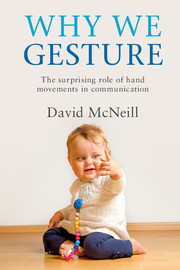Book contents
- Frontmatter
- Dedication
- Contents
- List of figures
- List of tables
- Preface
- Acknowledgments
- Part I Gesture-orchestrated speech
- 1 Why we gesture
- 2 The growth point
- 3 New forms of human action
- 4 Orchestration and unpacking
- 5 Mimicry and metaphor
- Part II Phylogenesis, ontogenesis, brain
- Part III The last page
- References
- Index
5 - Mimicry and metaphor
from Part I - Gesture-orchestrated speech
Published online by Cambridge University Press: 05 December 2015
- Frontmatter
- Dedication
- Contents
- List of figures
- List of tables
- Preface
- Acknowledgments
- Part I Gesture-orchestrated speech
- 1 Why we gesture
- 2 The growth point
- 3 New forms of human action
- 4 Orchestration and unpacking
- 5 Mimicry and metaphor
- Part II Phylogenesis, ontogenesis, brain
- Part III The last page
- References
- Index
Summary
Two further aspects of gesture-orchestrated speech are: (a) its social dimension, actuated in mimicry (the psychological predicates of one person appearing in another person); and (b) metaphoricity, bringing imagery to what is not imagery so that abstract, non-imagistic meanings can orchestrate speech. The chapter extends gesture-orchestrated speech in these directions. The conclusion I reach is that mimicry and metaphoricity are found in the very act of speaking itself, intrinsic to “new” gesture-actions, and are not add-ons.
Why mimicry?
Mimicry is perhaps the aspect of gesture-orchestrated speech least expected but it is frequent in human interaction: it is the orchestration of one's own speech by the gestures and speech of another. Mimicry gives new meaning to the old saw that language is social.
Voluntary mimicry can be socially aggressive, a kind of taunt, but involuntary mimicry marks rapport and is surprisingly frequent, especially when rapport is close (Kimbara 2006). It is important to emphasize that the mimicry we are considering is unconscious and involuntary. It need not be conspicuous. Micro-movements suffice. With it the mimic absorbs the other's growth point (GP), including the field of equivalents it differentiates. The mimicked GP follows the same path as one's own GP, having a gesture–speech unity, the GP itself, its differentiation of a field of equivalents, its unpacking and the speech it orchestrates. Such mimicry is a powerful instrument of social engagement or entrainment. Materialization through involuntary mimicry explains a frequently experienced but never remarked upon phenomenon: tip of the tongue contagion—when someone unexpectedly cannot recall a common word whose meaning is known and clear to everyone, often the interlocutors are also suddenly unable to recall it. “Mind merging” can include “tip-of-the-tongue merging” through involuntary mimicry (suggested by Liesbet Quaeghebeur, personal communication). Involuntary mimicry could be a product of the evolution of social thinking-for(-while)-speaking in small groups, possibly the bands described by Dunbar (1996), where it would have had adaptive value.
I was drawn to noticing it by seeing gesture-coders in our lab spontaneously mimicking gestures and speech in videos to clarify meanings. By replicating another person's gesture and speech, the mimic imports a gesture–speech unit. It is a tool for the coder to absorb and materialize an absent speaker's thought and speech and is also widespread in human interaction generally. We posed self-discovery examples utilizing mimicry in Chapter 1.
- Type
- Chapter
- Information
- Why We GestureThe Surprising Role of Hand Movements in Communication, pp. 86 - 106Publisher: Cambridge University PressPrint publication year: 2015



